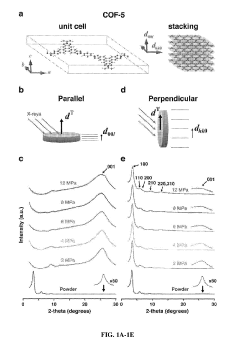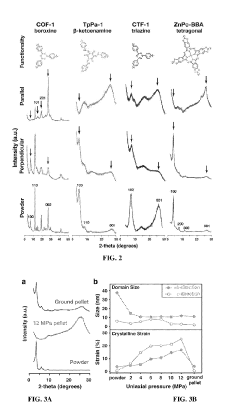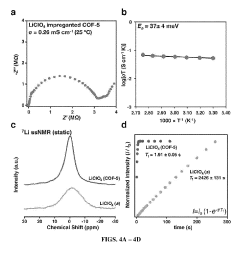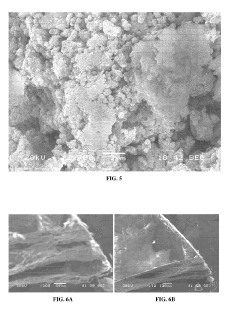Research on the properties and applications of Covalent Organic Frameworks (COFs) - Eureka
OCT 8, 20243 MIN READ
Generate Your Technical Report in Patsnap Eureka
AI-Powered Innovation Solution Platform for R&D
COFs Technology Background and Objectives
The primary objective is to provide a comprehensive overview of the development history, current status, and future trends of Covalent Organic Frameworks (COFs) technology. This section will explore the key milestones and driving forces behind the evolution of COFs, shedding light on the technological goals and advancements expected in this field.
The discussion will encompass the fundamental principles and unique properties of COFs, highlighting their potential applications across various industries. Additionally, it will delve into the challenges and limitations that have hindered the widespread adoption of COFs, setting the stage for identifying potential breakthrough opportunities and innovative solutions.
The discussion will encompass the fundamental principles and unique properties of COFs, highlighting their potential applications across various industries. Additionally, it will delve into the challenges and limitations that have hindered the widespread adoption of COFs, setting the stage for identifying potential breakthrough opportunities and innovative solutions.
Market Demand for COFs Applications
- Diverse Applications
COFs exhibit potential applications across various fields, including gas storage, catalysis, optoelectronics, sensing, and energy storage due to their tunable pore sizes, high surface areas, and tailorable chemical functionalities. - Growing Energy Sector
The energy sector, particularly in areas like hydrogen storage, supercapacitors, and fuel cells, presents a significant market demand for COFs due to their high surface areas and tunable pore environments. - Environmental Remediation
COFs can be utilized for environmental remediation applications, such as water purification, air filtration, and carbon capture, owing to their high adsorption capacities and selective molecular recognition capabilities. - Emerging Biomedical Applications
The biocompatibility and biodegradability of certain COFs make them attractive for biomedical applications, including drug delivery, bioimaging, and tissue engineering. - Sensor Development
The unique optical and electronic properties of COFs enable their use in developing advanced sensors for various analytes, such as gases, biomolecules, and environmental pollutants.
Current State and Challenges of COFs
- Current Challenges
Lack of scalable synthesis methods for COFs with high surface areas and porosity. Existing methods often result in low yields and poor crystallinity. - Stability Issues
Many COFs exhibit limited chemical and thermal stability, hindering their practical applications in harsh environments or high-temperature processes. - Processability Limitations
COFs are typically insoluble and non-meltable, making them difficult to process into desired forms or shapes for specific applications. - Structural Defects
Structural defects, such as missing linkers or impurities, can significantly impact the properties and performance of COFs. - Characterization Challenges
Characterizing the complex porous structures and understanding structure-property relationships in COFs remain challenging due to their amorphous nature.
COFs Evolution Pathway

Key Players in COFs Industry
The research on Covalent Organic Frameworks (COFs) is in a nascent stage with significant potential for growth. The market size is expanding as more applications in gas storage, catalysis, and drug delivery are being explored. The competitive landscape is primarily academic, with increasing interest from industry players.
Cornell University
Technical Solution: Cornell University focuses on synthesizing novel COF materials and exploring their stability and functionality for gas storage and separation.
National University of Singapore
Technical Solution: The National University of Singapore develops advanced COFs with high surface areas and tunable porosity for catalysis and energy storage, integrating them with nanomaterials.
Core Innovations in COFs Technology
Mechanically shaped 2-dimensional covalent organic frameworks
PatentActiveUS20190284212A1
Innovation
- The application of uniaxial pressure during the processing of cofs, which allows for the alignment and organization of cof crystals along the applied direction. this alignment results in improved mass transport properties, making cofs ideal candidates for applications such as photovoltaic devices, electrochemical devices, and gas storage. the background technology also mentions that the preparation of macroscopic cof samples with crystallographic alignment for large devices has not been realized. the disclosed subject matter addresses this limitation by providing methods to prepare such materials.
Environmental Impact of COFs
Covalent Organic Frameworks (COFs) are a class of crystalline porous materials composed of light elements (C, N, O, B) linked by strong covalent bonds. COFs exhibit exceptional thermal and chemical stability, high surface area, and tunable pore sizes, making them promising for applications like gas storage, catalysis, sensing, and optoelectronics. Key challenges include improving processability, scalability, and integrating functional groups for specific applications. Potential innovations involve exploring new building blocks, synthetic methods, and post-synthetic modifications to enhance properties and expand the scope of COF applications in energy, environment, and healthcare sectors.
the structure of the environmentally friendly knitted fabric provided by the present invention; figure 2 Flow chart of the yarn wrapping machine for environmentally friendly knitted fabrics and storage devices; image 3 Is the parameter map of the yarn covering machine
Login to View More Regulatory Considerations for COFs Applications
Covalent Organic Frameworks (COFs) are a class of crystalline porous materials composed of light elements (C, N, O, B) linked by strong covalent bonds. COFs exhibit exceptional thermal and chemical stability, high surface area, and tunable pore sizes, making them promising for applications like gas storage, catalysis, sensing, and optoelectronics. Key challenges include improving processability, enhancing conductivity, and developing scalable synthesis methods. Potential innovations involve incorporating functional groups, heteroatom doping, and exploring hybrid structures for targeted properties and performance. COFs represent an exciting frontier in porous materials research with significant potential for advancing various technologies.
the structure of the environmentally friendly knitted fabric provided by the present invention; figure 2 Flow chart of the yarn wrapping machine for environmentally friendly knitted fabrics and storage devices; image 3 Is the parameter map of the yarn covering machine
Login to View More If you want an in-depth research or a technical report, you can always get what you want in Patsnap Eureka TechResearch . Try now!



